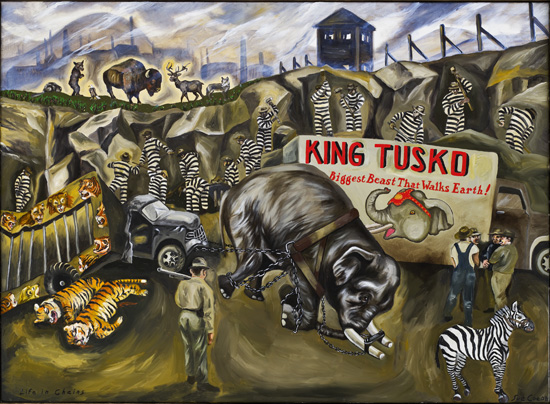Sue Coe at San Diego State University – Saturday, March 21 at 5:00 p.m.
“animalkind” exhibition reception – Saturday, March 21 from 6:30 to 8:00 p.m.
Visiting artist Sue Coe will present an illustrated lecture on Saturday, March 21 at 5:00 p.m. at SDSU in Nasatir Hall Room 100, in conjunction with the exhibition “animalkind.” An exhibition reception will follow at the University Art Gallery from 6:30 to 8:00 p.m. The lecture and reception are FREE and OPEN to the PUBLIC. The exhibition continues at the Gallery through May 6.

Sue Coe @ animalkind, SDSU Gallery
About Sue Coe
Sue Coe was born in Tamworth (Staffordshire), England and educated at the Royal College of Art in London, She emigrated to the United States in 1972. Settling in New York City, she initially pursued a career as an illustrator for such publications as The New York Times and Time Magazine. Finding her editorial assignments too constraining, however, she soon began doing extended series of larger paintings and drawings on subjects of her own choosing. Sue became a “star” of the East Village scene in the early 1980s, with works depicting such notorious current events as Bernard Goetz’s subway shooting and the rape of a woman on a pool table in a New Bedford, MA, bar. (The latter painting is now in the permanent collection of The Museum of Modern Art.) Coe’s first book-length series, “How to Commit Suicide in South Africa” (1983), was used as an anti-apartheid organizing tool on college campuses nationwide. She has since published illustrated books on Malcolm X (“X,” 1986), the meat industry (“Dead Meat,” 1996) and related animal rights subjects (“Pit’s Letter,” 2000 and “Sheep of Fools,” 2005).
About Sue Coe’s work in “animalkind”
Sue Coe critiques the controversial handling of captive elephants by recounting their historical abuse by the early animal entertainment industry. Her vividly detailed paintings from the series Elephants We Must Never Forget relate the true and tragic stories of famed circus and road-show pachyderms of the late-nineteenth and early-twentieth centuries. Tusko, Alice, Jumbo, Topsy, Mary and Tom Thumb all had been captured in the wild, subjected to lives of painful servitude alongside their fellow animal performers, and in most cases, condemned to violent and untimely deaths. Coe’s cautionary tales are particularly relevant at a time when there is much discussion of the detrimental effects of elephant captivity in circuses and zoos, and much debate about how best to prevent the animal’s extinction while preserving its dignity, social structure and physical well-being.
Image: Sue Coe, King Tusko: Life in Chains, 2008; oil on canvas, 30 x 42 inches; courtesy of the artist and Galerie St. Etienne, New York

